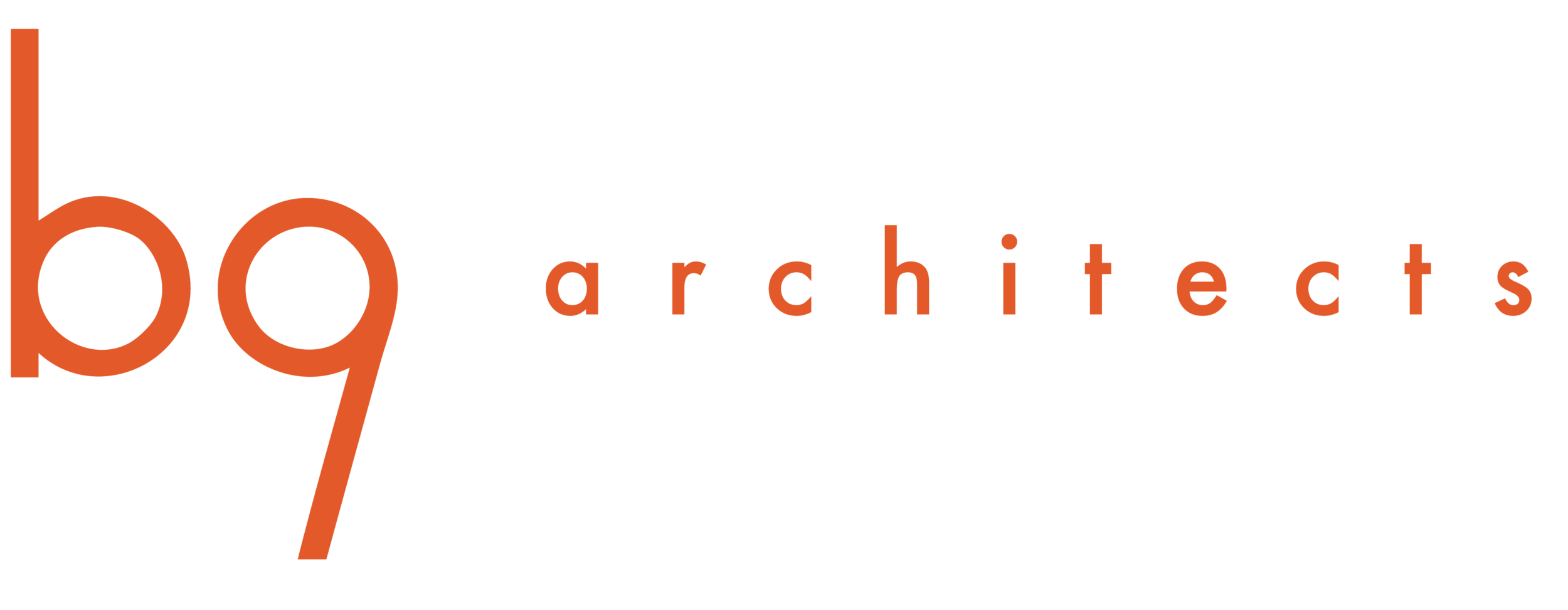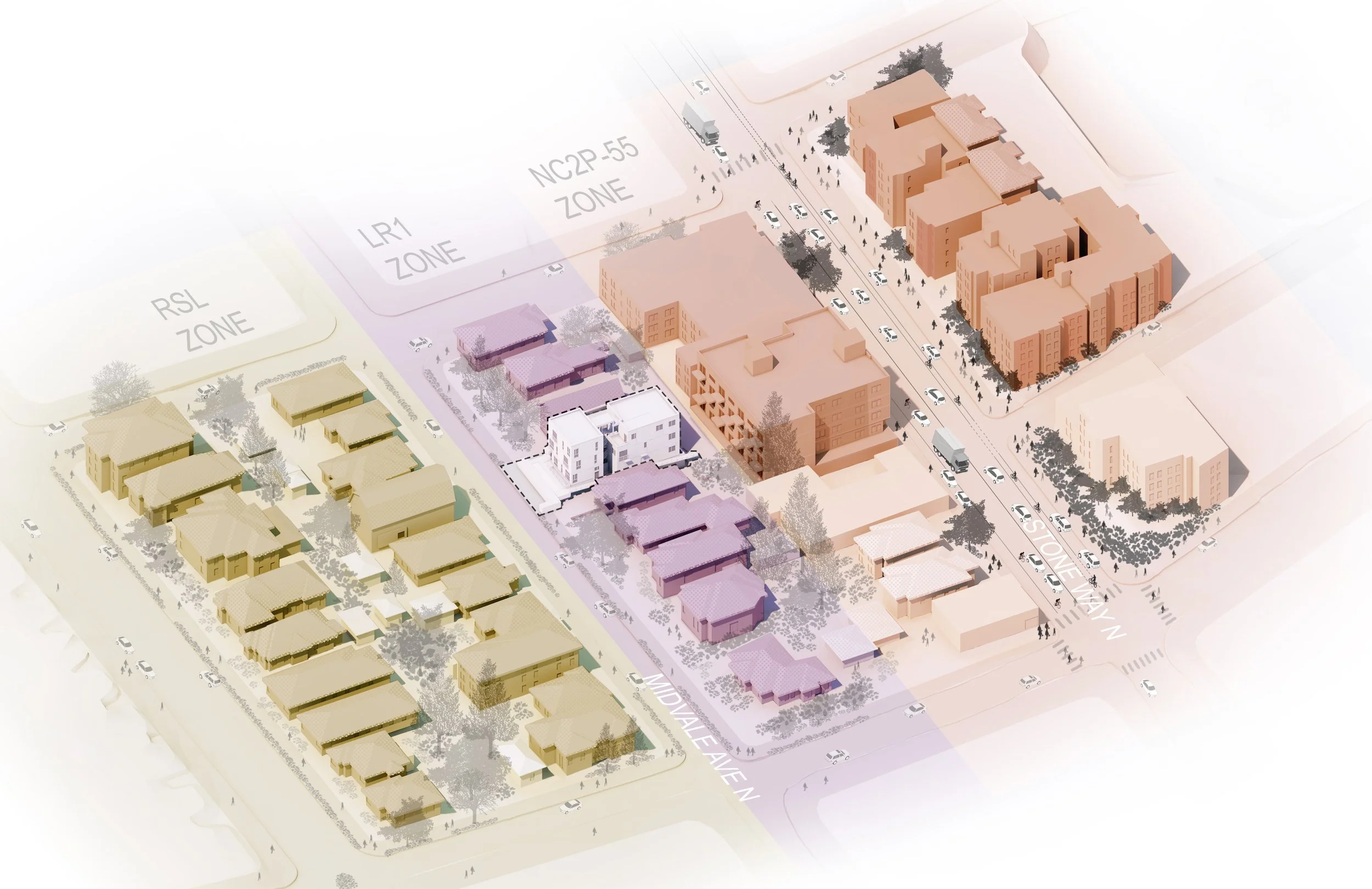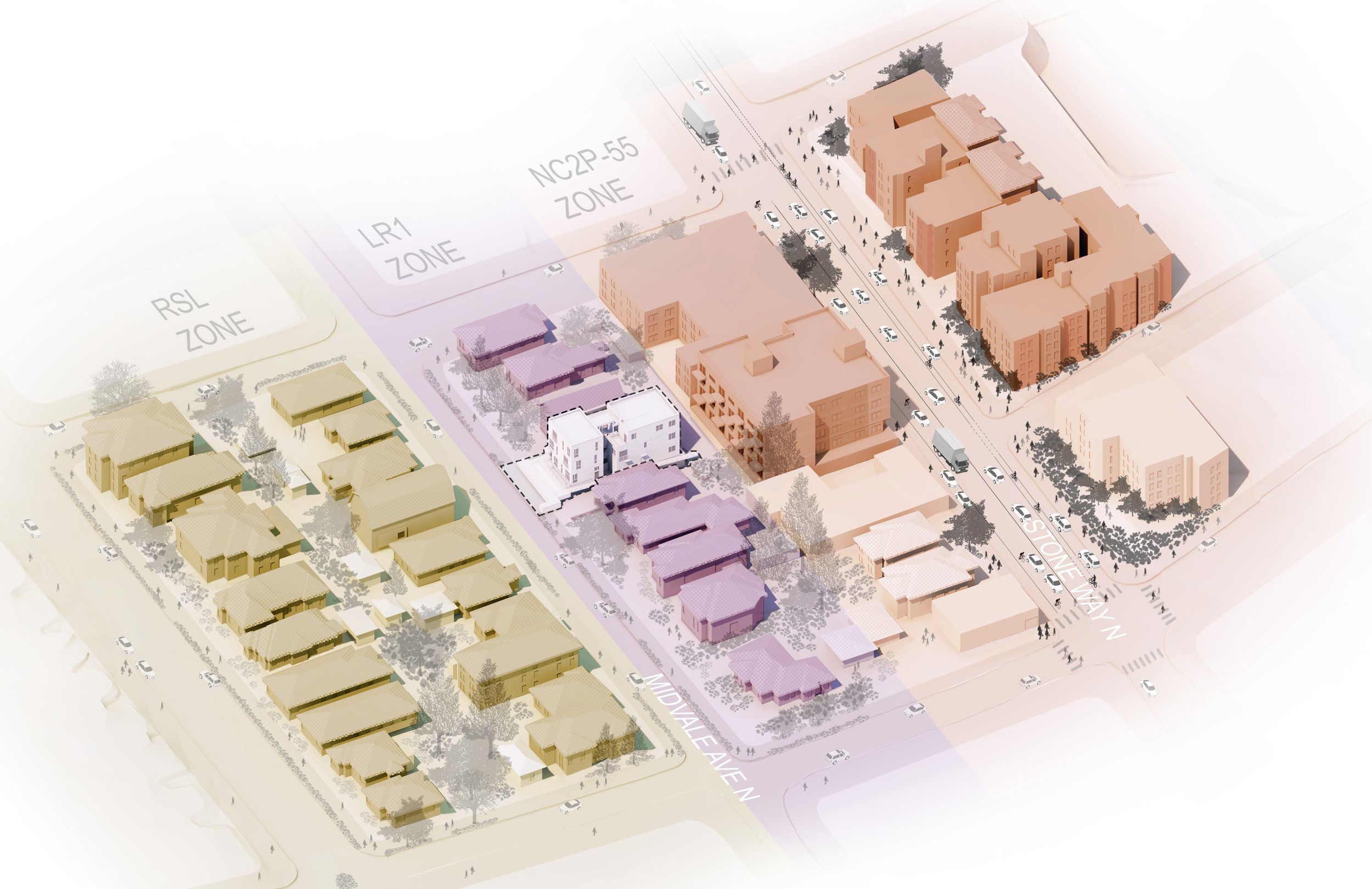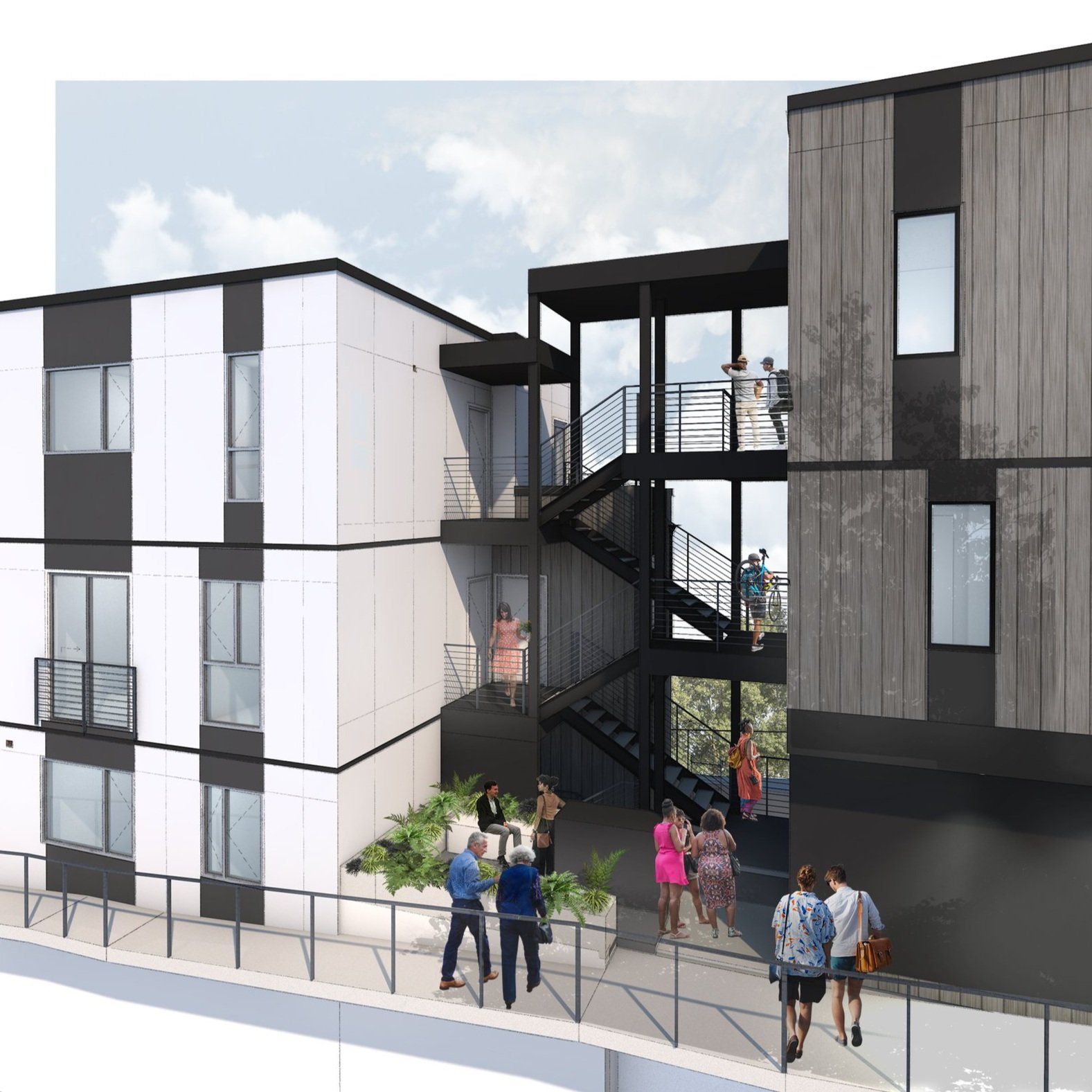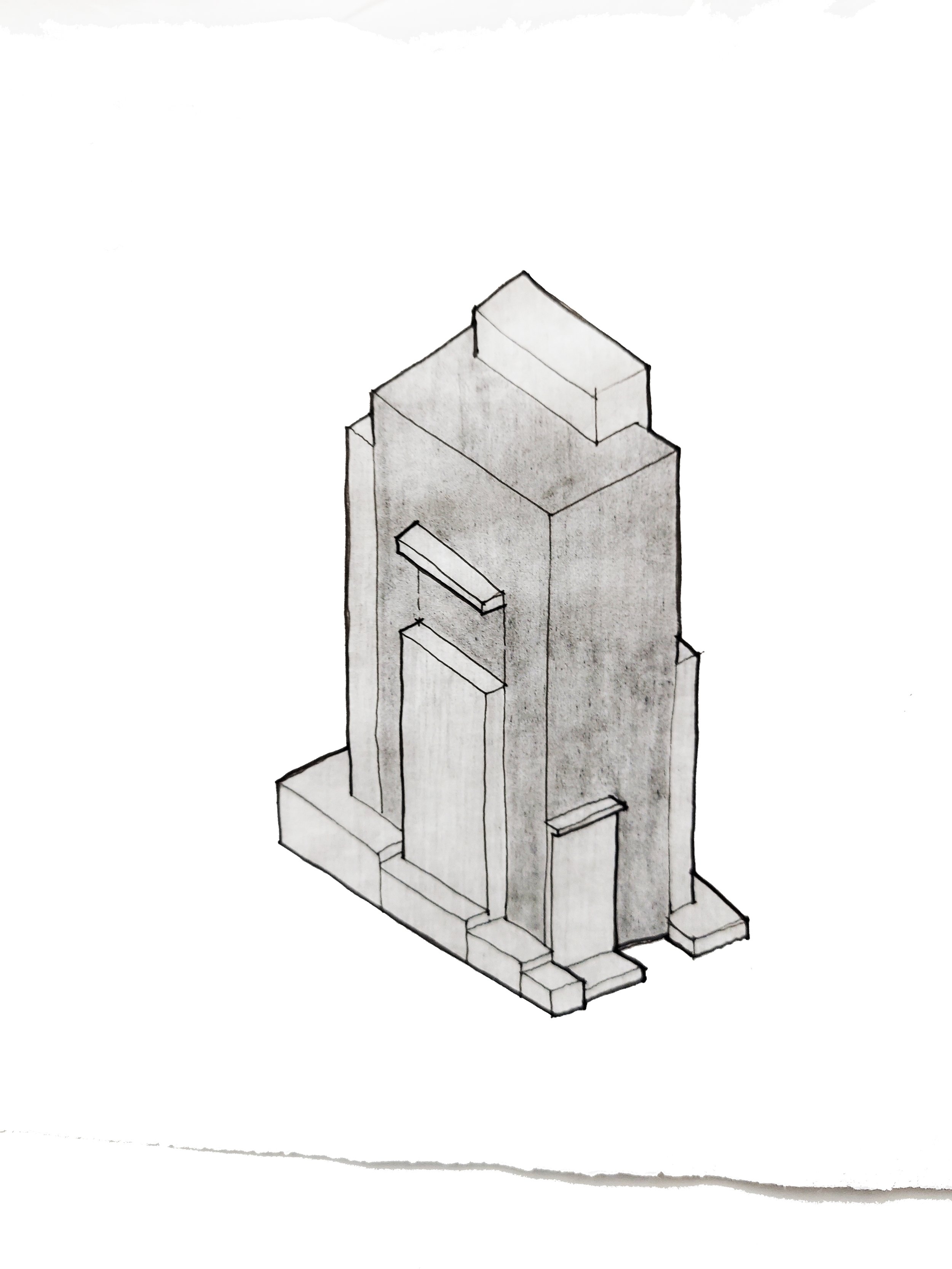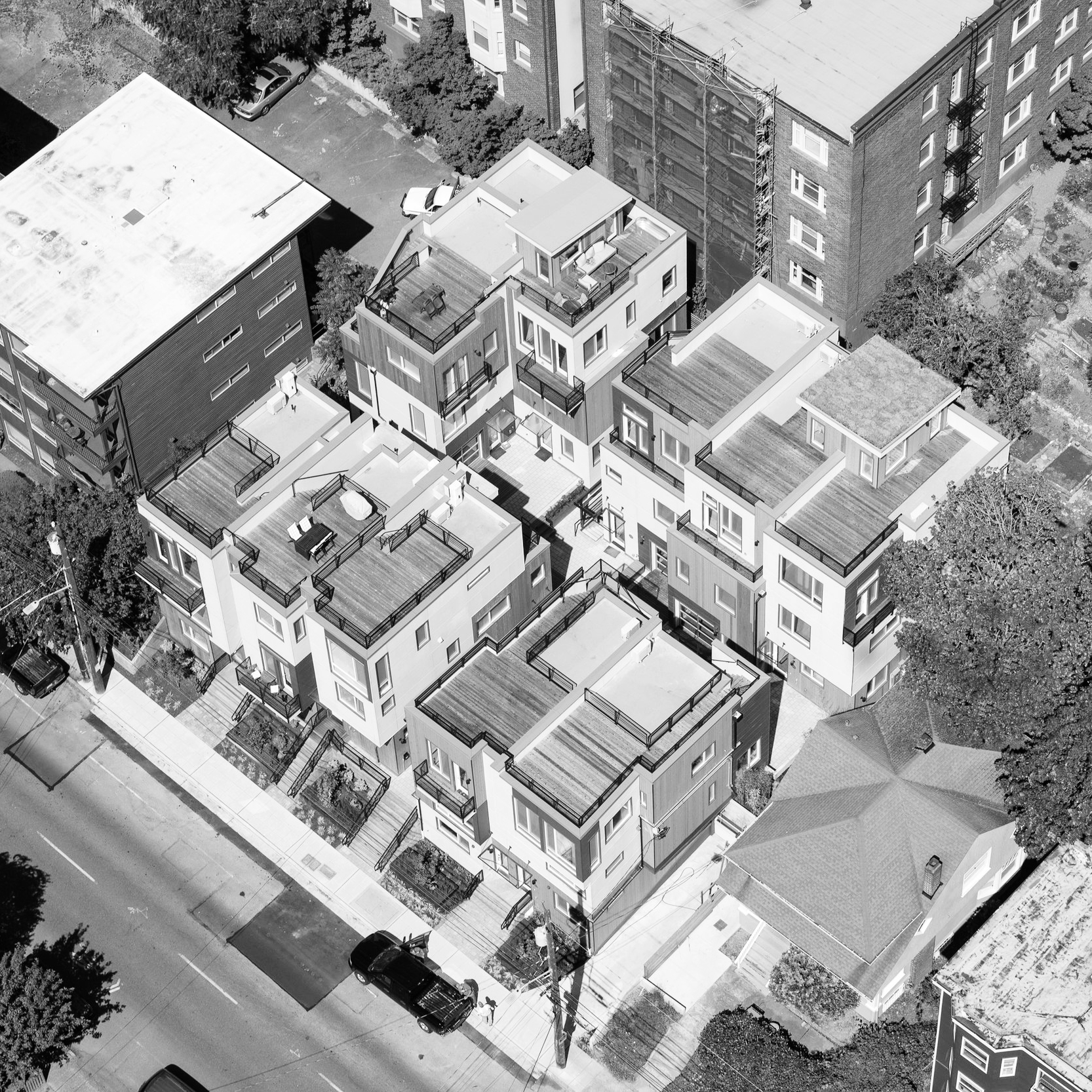Happy New Year! At b9 architects, we have the good fortune of having a large portfolio of completed works. Due to the diligence and expertise of our clients, the majority of the residential projects we’ve designed are completed, a feat not all architecture firms have. In 2022, we examined a couple projects that, due to the economic realities of Seattle, were canceled mid-process. Due to the increasing costs of construction, longer permit entitlement processes, and current incentivisation programs in the municipal code - creating dense, rentable residential units is not always cost effective, especially on small or complicated sites. Here are case studies of two projects that did not move forward.
Midvale Apartment
The Midvale Apartment Building and its surrounding neighborhood were up zoned when the City of Seattle implemented the Mandatory Housing Affordability (MHA) legislation in 2019. Properties facing the main arterial, Stone Way, remained in the Neighborhood Commercial zone but received a height and allowable area increase. The neighborhood to the west was largely shifted from the exclusive Single Family zone to the more flexible Residential Small Lot zone. Our site, however, and everything on the half block between the two received the intermediate Lowrise Multi-Family designation.
As a potential transitional space between the more active Commercial Stone Way and the classic Seattle Single Family neighborhood, this site appeared to us as a space designated for small-scale, dense, rental housing. But in implementation, the zoning allowance does not reflect the true cost. A family-sized unit requirement, a one-time MHA fee payment, and construction complications made an apartment building at this site with the height and area restrictions infeasible.
This Axonometric View of the surrounding blocks of the proposed project on Midvale Avenue North represents the existing zoning and development and in particular, it diagrams the different scales of surrounding residences and buildings between zones
While the MHA implementation unlocked this half block strip for potential multifamily redevelopment, higher density housing came with a family-sized unit requirement. For every 4 proposed units, one 2-bedroom (minimum 850 square feet) or for every two 2-bedroom units a single 3-bedroom unit (minimum 1,050 square feet) must be provided. In addition, any development under MHA (that does not provide affordable housing on site as part of the development) incurs a fee that must be paid to the city of Seattle before a building permit can be issued. The fee is a variable dollar amount per square foot that changes based on location within the City and the extent of the upzone. Alternatively, a project can choose to designate a portion of their units to rent for significantly less than market value for the first 75 years of the project. In our experience, the client almost always chooses the fee due to the complication of renting units through a city managed program and the future potential loss of rental income. At the same time, construction costs due to a lack of staging space on midblock sites, supply chain issues, and other national economic difficulties caused our client to rethink this project and focus elsewhere. The multiple requirements that previously would have made the projected income tight, but feasible, became too constricting as the project became short on projected rental income and desired number of overall units. We believe the zoning intended to create small apartment buildings with family-sized units, providing increased density near a commercial zone while also transitioning towards the more residential blocks of the existing neighborhood. Instead, due to the complexity described above, small townhouse structures and additional single family dwellings are being developed along this same zoning block. This is achieving a greater density than what previously existed, but still is creating single-family living at higher cost to future residents. Following the permitting of the small-scale 13-unit apartment building, our client chose to sell the site, resulting in the creation of a single family unit and a duplex structure.
As much as the City of Seattle needs to solve the lack of affordable housing and needs the addition of more family-sized rental units to the housing market, passing the cost of multiple housing initiatives - when applied at such small infill sites - onto the developer incentivizes the developer to avoid them entirely, where they instead pursue more predictable projects with a greater financial upside and less risk.
Pictured is the proposed apartment project viewed from Midvale Ave N to the Northeast
An entry sequence was designed to bring residents and guest to the central open space of the site
The central space was designed to feel very open to allow air and light to activate the site and shared apartment spaces and to provide neighboring sites with massing relief
Fir Street
A very small site in Seattle’s Midrise Residential zone, the Fir Street project came to b9 architects as an apartment, proposed to take advantage of the increased capacity allowed under the MHA upzone.
The site is located on a small peninsula of Midrise zone that is adjacent to the Yesler Terrace Master Planned Community and to the south of a small Neighborhood Commercial zone. This site is visible from adjacent rights-of-way as it is surrounded by two parking lots and a garden owned by the neighboring Japanese Baptist Church to the west and the north, with an alley to the east. A pocket park is located across the street and the immediate context features many large new multifamily apartment structures that are part of the Yesler Terrace Master Planned Community.
This Axonometric View of the surrounding blocks of the proposed project on E Fir Street and Broadway depicts the existing zoning and development and in particular, it diagrams the much larger scales of surrounding residences and buildings as well as the relative small size of the lot occupied by the proposed project.
The originally proposed massing for apartments on E Fir Street
The site dimensions and height allowance result in a vertical structure that helps anchor the pocket park across E Fir Street to the south and respond to the larger surrounding developments. The proposal addresses this unique circumstance and emerges from a clear design concept. In response, the massing consists of an aggregation of “basalt columns” of various widths and heights. These columns combine to create a subtle, yet dynamic building mass and landscape concept. This design concept produces numerous modulations and material changes along all facades of the building. The termination of the “columns” at different elevations along the facade creates opportunities for balconies, which further activate the facades of the building.
The project’s height is consistent with many of the newer buildings in the Yesler Terrace Master Planned Community to the south and west while the footprint is more consistent with the fourplexes, townhouses, and smaller apartment buildings to the east and north. Due to the small lot area, 2,400 square feet, the building would be unlike anything in the neighborhood. An innovative, 6-story apartment building, this Yesler Terrace project, touted by the DJC as an “infill infill project” would have yielded 15 rental units. The project was required to go through the city of Seattle’s Streamlined Design Review process as part of the permitting process. Through this process, we proposed modifications to reduce the setbacks required in Seattle’s land use code in order to achieve the project goals of an infill apartment on this incredibly unique site. In our experience Design Review can and should allow for flexibility in order to respond to unique sites such as this one. The design proposal was significantly less area than what is allowed by code. Unfortunately, the Design Review process resulted in a strict application of the land use code, eliminating the necessary area to make the “infill” infill apartment feasible. That, combined with the cost of construction, became untenable and so the project shifted to a less risky townhouse scope.
The proposed massing for the project featuring 15 units provided on site
The current proposal for 3 townhomes on the same site, currently in process
The height and capacity allowance in the Midrise zone, does not have the incentives necessary to take full advantage when the site does not conform to certain characteristics including size, access to utilities such as storm and sewer, and being clear of environmental critical areas like steep slopes or wetlands. While b9 architects, inc. enjoys designing townhouses and seeing their impact on the City, we recognize a need for a variety of housing solutions.
Over the past 20 years, b9 architects has garnered expertise in maximizing Seattle’s sites in smart and well-designed ways. Clients often choose our firm to help them navigate difficult sites, or design innovative projects to compete with larger rental properties down the street. In our experience, these small 10-30 unit infill apartments tend to be the projects most difficult to meet the financial model necessary to build. If the market isn’t completely on board, developers stop completely or change typology.
In 2023, we hope to explore ways to incentivize small and medium multifamily solutions to help our clients and partners better achieve the combined goals of better, denser, and more affordable housing in Seattle’s neighborhoods. This will include examining the necessary code changes to expand the access to housing opportunities and levels of affordability in the current Neighborhood Residential zones.
